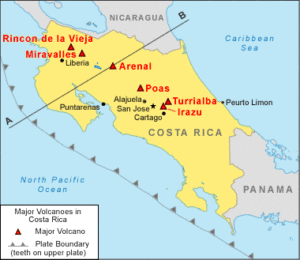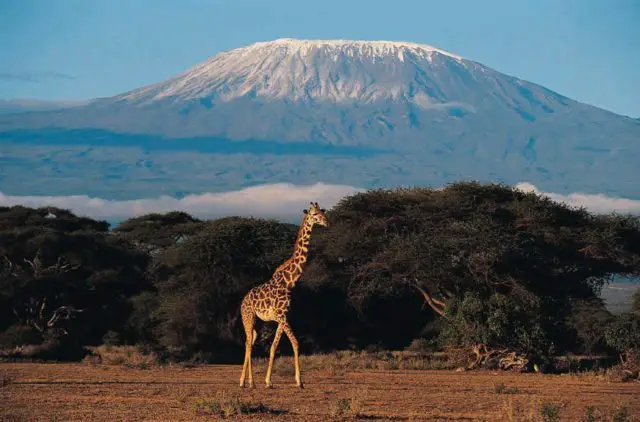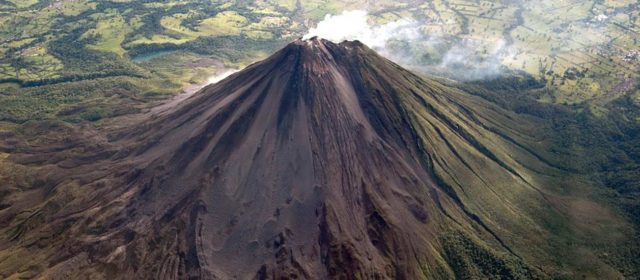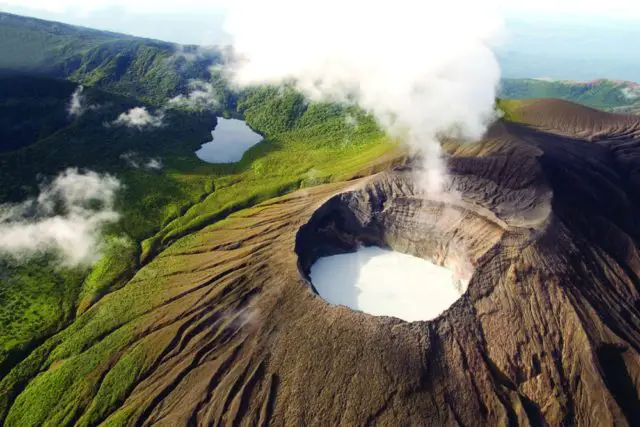As part of the Ring of Fire, a string of volcanoes and sites of seismic activity that surrounds the basin of the Pacific Ocean. Costa Rica hosts several volcanic formations. Most of them lie in the northern part of the country and in the Central Highlands.
These formations are grouped into 3 volcanic range systems: The Guanacaste Range that includes Rincón de la Vieja, Orosí, Miravalles, Tenorio, and Arenal volcanoes. The Central Volcanic Range is made up of the Poas, Barva, Irazú, and Turrialba volcanoes. The Talamanca Range has only 1 volcano: El Viejo.

(And now the science class part…)
* Even though classifying them is not an easy task, volcanologists, the guys that study volcanoes, say that they can be active, dormant, or extinct.
* An active volcano is one that is currently erupting or has erupted recently, Mount St. Helens, in Washington which last erupted in 1980 and Kīlauea in Hawaii, which has been erupting since 1983, and which is probably the world’s most active volcano, belong in this category.
* A dormant volcano is one that has not erupted recently, but that is expected to do it again. Before its last eruption, Mount St. Helens had been labeled as dormant. Chaitén Volcano in Chile, which erupted in 2008 after a lull of almost 10,000 years, is another case in point.
* An extinct volcano is one that volcanologists think will never erupt again, for instance, Huascarán in Perú, or the iconic Kilimanjaro in Tanzania.

* When it comes to measuring how strong an earthquake is, scientists have the Richter scale. Volcanos have a similar scale called the Volcanic Explosivity Index (VEI). The VEI was devised by Chris Newhall of the United States Geological Survey and Stephen Self at the University of Hawaii in 1982.
Based on values such as the volume of products ejected, eruption cloud height, and qualitative observations and terms that go from “gentle” to “mega-colossal”, volcanologists give each eruption a number from 1 to 8 to indicate the magnitude (erupted volume) and intensity (eruption column height) of an eruption.
* The Volcanological and Seismological Observatory of Costa Rica (OVSICORI) at the Universidad Nacional de Costa Rica. OVSICORI studies and monitors all the volcanic activity in the country. When the volcanoes get ” angry” everybody in Costa Rica pays to heed to what OVSICORI says.
* About 61 of Costa Rica’s volcanoes are considered dormant or extinct while only 6 are active. This amount is something really remarkable for a country of its size.
(Wake up people, the class is out!)
Volcanoes Poas, Irazu, Arenal, Rincón de la Vieja, Tenorio, and Turrialba are the crown jewels of Costa Rica’s geological tourism. Due to their natural beauty and the many possibilities they offer both for adventure and relaxation, these active volcanoes are very popular among tourists as preferred vacation spots.
Arenal and Poás vie for the title of “the most famous” of all Costa Rica’s volcanoes. Arenal is one of the ten most active volcanos in the world, and it was until recently the most active volcano in the country. After being dormant for centuries, in 1968 Arenal suddenly erupted and destroyed Tabacón, a small town nearby. It is been dormant since 2010.

Poás Volcano. It is also a well-known tourist destination. Inside its crater, there is the Laguna Caliente (Hot Lake), which is one of the largest acidic lakes on the planet. Although without a major eruption since 1910, Poás has seen a great deal of activity lately and as from October 2017, the park has been closed to the public.
Irazú Volcano. It is locally known as “El Coloso”, because harbors inside its crater a mineral-laden lake that has been known to change colors, from emerald green to wine red. The volcano is within easy reach of San Jose and even though clear days are rare, on such days it is possible to see both the Atlantic and Pacific Oceans from its summit.
Rincón de la Vieja Volcano. It has a network of hiking trails and interesting spots like active fumaroles and bubbling mud ponds that attract many tourists every season. Due to high volcanic activity and dangerous gases that come out of the volcano’s crater and vents, some of the trails are currently off limits.

Turrialba Volcano. It is located about 50 kilometers from San José, has also seen some important eruptions. In 2015 and 2016, the ashes and debris from some of those forced the country’s aviation authorities to close down the capital’s airport.
Tenorio Volcano. It is located in Guanacaste. The cone is surrounded by lush forests abundant with exotic wildlife such as tapirs, ocelots, and jaguars. Several geysers, waterfalls, and hot springs can be found there as well. There is a winding trail to the very summit.
Of course, there is always an element of danger when you visit an active volcano but in the true spirit of Costa Rica’s attitude. That is also “Pura Vida”!
